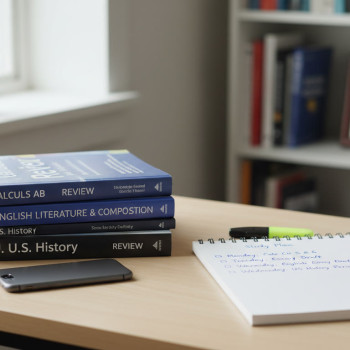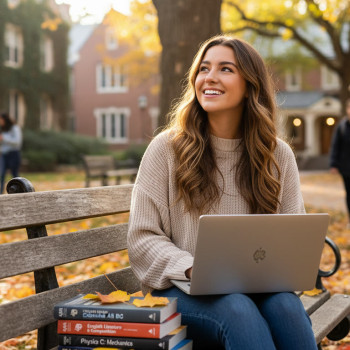Why Speaking and Listening Matter in AP Language
If you’re taking AP English Language and Composition, you probably know the course focuses on reading, writing, and rhetoric. But often underestimated are the speaking and listening skills that tie everything together. Whether you’re participating in classroom discussions, delivering a brief presentation, or listening critically to peers, these moments are where ideas breathe and evolve.
This blog gives you a clear, human-centered speaking and listening calendar you can follow across a semester or school year. It’s practical—built around weekly themes, short daily habits, and regular assessment points. You’ll find examples, a sample grading rubric, and a data table to help you track progress. And, when it fits naturally, I’ll point out how Sparkl’s personalized tutoring can help sharpen the skills that matter most.

How to Use This Calendar
This calendar is flexible. Use it as a scaffold for a 12-week unit, or stretch it into a full semester by pacing each week over two classroom sessions. Each week has a theme, one core speaking task, one listening goal, and a short formative assessment. The calendar assumes you already have the AP course framework in mind and focuses on skills you can practice without special equipment.
Tips before you begin:
- Be consistent: 15–30 minutes a day of focused oral practice adds up quickly.
- Record yourself sometimes: you’ll notice patterns that aren’t obvious in the moment.
- Rotate roles in group work: speaker, responder, summarizer, and questioner—each role trains a different skill.
12-Week Speaking & Listening Calendar (Overview)
Below is a compact weekly guide. After the table, each week is expanded with concrete prompts and assessment ideas.
| Week | Theme | Core Speaking Task | Listening Goal | Formative Assessment |
|---|---|---|---|---|
| 1 | Rhetorical Awareness | 2-min rhetorical précis out loud | Identify rhetorical situation in short audio | Self-reflection journal |
| 2 | Claim & Evidence | Elevator pitch w/ evidence | Spot strong vs weak evidence | Peer feedback checklist |
| 3 | Audience & Tone | Adapt message to two audiences | Analyze tone shifts in speech | Teacher rubric |
| 4 | Organization | 3-point mini-presentation | Listen for signposting | Recorded delivery score |
| 5 | Concession & Complexity | Concession paragraph orally | Recognize nuance in arguments | Peer debate |
| 6 | Stylistic Devices | Use rhetorical devices in speech | Identify devices in audio | Device log |
| 7 | Research Synthesis | Synthesized 5-min oral report | Listen for source integration | Annotated bibliography + oral |
| 8 | Visual & Multimedia | Present with an image/slide | Evaluate multimedia choices | Peer and teacher critique |
| 9 | Impromptu Skills | 1–2 minute impromptu | Summarize impromptu points | Quick-response scores |
| 10 | Discussion Leadership | Lead a 15-min seminar | Practice active listening moves | Leader reflection form |
| 11 | Revision & Reflection | Rework an earlier speech | Compare first vs revised listening | Portfolio submission |
| 12 | Mock Assessment | Recorded 6–8 minute presentation | Peer scoring & self-assessment | Summative rubric |
How to expand or compress this schedule
If your class meets less often, convert each week into a two-week module—Week A focuses on practice and teacher modeling, Week B on performance and assessment. If you have more time, deepen research synthesis work or add cross-curricular speaking assignments tied to history or science content.
Week-by-Week: Practical Prompts and Rubrics
Weeks 1–3: Building Rhetorical Groundwork
Goal: Help students speak clearly about texts and spot rhetorical strategies when listening.
- Week 1 Prompt: Read a short editorial (300–500 words). Prepare a two-minute rhetorical précis that identifies purpose, audience, tone, and two key rhetorical strategies. Record and listen back. Write one sentence you’d change to make the argument clearer.
- Week 2 Activity: Create an elevator pitch for a position (e.g., school uniform policy). Include a clear claim and two pieces of evidence. Swap with a partner; the listener must classify each piece of evidence as anecdotal, statistical, or testimonial.
- Week 3 Task: Take a short persuasive paragraph and present it twice—once for a parent audience and once for a peer audience. Notice shifts in vocabulary, examples, and tone.
Formative assessment example: A simple 6-point checklist—clarity of claim, use of evidence, vocal projection, pacing, audience awareness, and successful use of a rhetorical move (ethos, pathos, logos).
Weeks 4–6: Structure, Complexity, and Stylistic Control
Goal: Teach students to organize aloud, to incorporate complexity, and to use stylistic devices effectively.
- Week 4: Ask students to craft a three-point mini-presentation. Each point should have a signpost phrase (“First,” “Next,” “Finally”). Use peers to track transitions and timing.
- Week 5: Introduce concession language. Prompt: “Argue for X while acknowledging a significant counterargument.” Encourage phrases like “Although critics argue…, it’s also true that…”
- Week 6: Device day—students practice one or two rhetorical devices (anaphora, parallelism, metaphor) in a short speech and receive targeted feedback on effect and clarity.
Weeks 7–9: Synthesis, Media, and Spontaneity
Goal: Build skills to integrate sources into oral work, to use visuals responsibly, and to think on one’s feet.
- Week 7: Synthesis oral report—students use three short sources and present a five-minute integrated summary. Assess source attribution and balance (no single source should dominate more than 50% of the talk).
- Week 8: Visual integration. Students choose an image, infographic, or short clip to support a claim. Practice describing the visual, explaining its relevance, and signaling any limitations.
- Week 9: Impromptu rounds—students draw from a bowl of prompts and speak for 90 seconds; listeners practice summarizing in 20 words or less.
Weeks 10–12: Leadership, Revision, and Mock Assessment
Goal: Give students the experience of leading discussions, revising oral work, and preparing for a formal recording or timed delivery.
- Week 10: Seminar leadership—students plan and lead a 15-minute seminar using Socratic questions. Assessors note the leader’s ability to open inquiry, manage time, and invite participation.
- Week 11: Revision lab—students choose an earlier speech, incorporate feedback, and re-record. Compare timestamps to track reduction of filler words and improved clarity.
- Week 12: Mock assessment—record a polished 6–8 minute presentation that demonstrates synthesis, rhetorical sophistication, and polished delivery. Use the summative rubric below to score.
Sample Summative Rubric (Out of 24 Points)
| Category | Criteria | Points |
|---|---|---|
| Argument & Content | Clear thesis, relevant evidence, synthesis of sources | 0–8 |
| Organization | Logical flow, signposting, strong intro/conclusion | 0–6 |
| Delivery | Vocal clarity, pacing, eye contact or camera presence | 0–6 |
| Listening & Response | Quality of answers to follow-up questions and active listening | 0–4 |
Use this rubric as a guide for both peer and teacher feedback. A combined score of 18+ indicates strong readiness for AP-style oral tasks; 14–17 suggests targeted revision, and below 14 means revisit fundamentals.
Daily Micro-Practices: 10–15 Minutes That Shift Performance
In addition to weekly tasks, these micro-practices will sharpen the muscles you use for speaking and listening:
- One-minute summarization: after reading a paragraph, explain it aloud in exactly 60 seconds.
- Pacing drills: read a short paragraph at three speeds—too fast, too slow, and conversational—then identify the most effective pace.
- Question practice: when you listen, write one clarifying question and one evaluative question.
- Filler word count: record for two minutes and tally filler words; aim to halve that number in two weeks.
Classroom and Remote-Friendly Assessment Ideas
Whether your classroom is face-to-face, hybrid, or fully remote, these assessment formats work well:
- Live mini-debates scored by peers with a short teacher rubric.
- Recorded oral portfolios submitted across the term (good for asynchronous classes).
- One-on-one interviews with the teacher—great for targeted feedback and differentiation.
- Fishbowl discussions where an inner circle debates and an outer circle listens and provides meta-feedback.
Example Peer Feedback Form (Quick)
- Did the speaker state a clear claim? Yes / Sometimes / No
- Best piece of evidence used:
- One thing to strengthen: (specific and actionable)
- Delivery note: (volume, phrasing, pace)
Tracking Progress: A Simple Student Tracker
Keep a weekly tracker for one semester. Track one primary metric from each category: thesis clarity, evidence integration, organization, and delivery. Update weekly to watch growth. Small wins are motivating—capture them.
| Week | Thesis Clarity (1–5) | Evidence Integration (1–5) | Organization (1–5) | Delivery (1–5) | Notes |
|---|---|---|---|---|---|
| 1 | 3 | 2 | 3 | 2 | Nervous, many fillers |
| 6 | 4 | 3 | 4 | 3 | Improved signposting |
| 12 | 5 | 4 | 5 | 4 | Strong synthesis, fewer fillers |
Using Technology: Tools That Help (Without Overdoing It)
Technology should support learning rather than replace practice. Useful tools include simple audio recorders, screen recording for presentations, and a shared spreadsheet for peer feedback. When students listen back, they often notice clarity, pacing, and repetition patterns faster than teachers can point them out.
For personalized support—especially when students are struggling with specific oral skills—consider targeted tutoring. Sparkl’s personalized tutoring offers 1-on-1 guidance, tailored study plans, expert tutors, and AI-driven insights that can help identify patterns in delivery and craft improvement strategies. A short series of sessions focused on pacing, evidence integration, and impromptu responses can make a big difference ahead of summative assessments.
Classroom Culture: Making Risk-Taking Safe
Good speaking and listening practice depends on a classroom culture where risk is encouraged and feedback is kind and specific. Teach students how to give feedback: start with what worked, then offer one specific suggestion, and end with encouragement. Rotate roles so every student both gives and receives critique; hearing a range of responses prepares you for the unpredictable nature of AP tasks.
Examples: What Strong and Weak Responses Look Like
Strong response example (synthesized): “Today I’ll argue that the city should expand bike lanes because studies show a 12% reduction in commute time for mixed-traffic routes, residents report greater satisfaction with local air quality, and small-business foot traffic increased in comparable districts. While some worry about parking loss, pilot programs show the net economic benefit outweighs the costs when paired with parking reforms.” Clear claim, three pieces of evidence, concession, and a logical structure.
Weak response example: “I think we should have more bike lanes. They’re nicer and safer. People like them.” Lacks precise evidence, structure, and depth.
Preparing for AP-Style Oral Tasks and Listening Demands
The AP English Language exam focuses on rhetorical analysis and argumentation; while there may not be a formal oral exam, the skills you build through speaking and listening transfer directly to writing and synthesis tasks. You’ll be better at structuring essays, integrating sources, and anticipating counterarguments—skills that matter for every free-response prompt.
Practice with timed speech, synthesis of multiple sources, and quick analysis of unfamiliar texts. These habits mirror the cognitive demands of the AP exam and reduce the surprise factor when you’re asked to pull together evidence quickly.
Common Pitfalls and How to Avoid Them
- Over-reliance on notes: Practice speaking with minimal prompts to build fluency.
- Under-prepared concessions: Teach students to identify the most persuasive counterargument and address it briefly.
- Poor listening habits: Train students to take two-line notes—first line for gist, second for a critical question.
- Performance anxiety: Small, consistent wins (like a daily one-minute summary) reduce anxiety more than last-minute cramming.
Final Checklist Before a Summative Oral Assessment
- Clear thesis with signposting.
- At least two integrated sources, correctly referenced in speech.
- Explicit concession or acknowledgment of complexity.
- Practice recording and listen-back for pacing and filler words.
- Prepare three probable follow-up questions and practice concise answers.

Wrapping Up: Make Speaking and Listening Part of Your AP Identity
Speaking and listening aren’t add-ons to AP Language—they’re part of the toolkit you’ll use to think publicly, persuade clearly, and listen critically. Use the calendar above as a living document: adapt it to your class rhythm, your interests, and your growth areas. Celebrate small improvements—reduced filler words, clearer thesis statements, stronger evidence usage—and keep practicing.
If you want extra structure, targeted practice, or one-on-one feedback, a short tutoring engagement can be especially effective. Sparkl’s personalized tutoring offers tailored study plans and AI-informed feedback that highlight exactly where a student’s oral skills will benefit most from focused work—whether that’s pacing, evidence integration, or impromptu confidence. When paired with regular classroom practice, these sessions can accelerate readiness and confidence.
Final Thought
AP Language is as much about thinking as it is about speaking. When you practice saying your arguments aloud and listening with purpose, your writing deepens, your analyses sharpen, and your confidence grows. Follow this calendar with curiosity, measure your progress, and take advantage of targeted help when you need it—then watch how your voice becomes one of your strongest AP tools.
Good luck—and enjoy the surprise of how much clearer your ideas become when you say them out loud.


















No Comments
Leave a comment Cancel